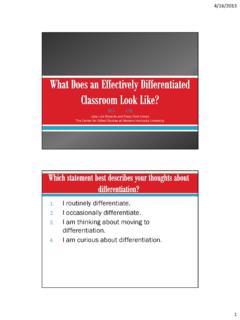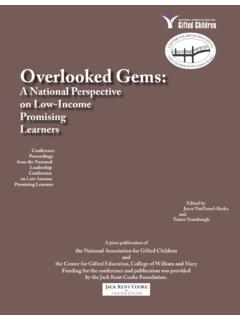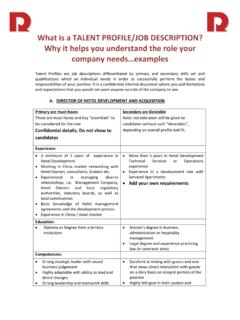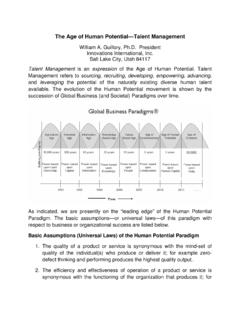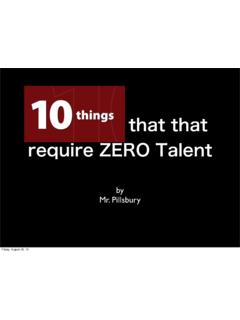Transcription of Unlocking Emergent Talent - nagc.org
1 Unlocking Emergent Talent :Supporting High Achievement of Low-Income, High-Ability StudentsPaula Olszewski-Kubilius and Jane ClarenbachpPaula Olszewski-Kubilius, , is President of the National Association for Gifted Children and Director of the Center for Talent Development at Northwestern University. Jane Clarenbach, , is Director of Public Education at the National Association for Gifted Children. 2012 National Association for Gifted Children | Washington, DC | of ContentsExecutive Summary .. 3 Introduction .. 5 Top-Achieving Students in the United States Today: An Overview .. 6 Barriers to Participation in Advanced Programs for .. 9 Low-Income, High-Ability StudentsSuccessful Program Models and Practices with ..12 Low-Income, High-Ability StudentsProgram Replication and Scale-Up Challenges ..15 More Than Ability is Required: Psychosocial Issues and ..16 Skills Needed for SuccessPolicies and Action Initiatives to Promote Talent Development.
2 19 of Low-Income, High-Ability StudentsMoving Towards a New Paradigm: Expanding Our Understanding ..21 of Gifted and TalentedBest Educational Practices with Low-Income, High-Ability Students ..22 Research Agenda to Support Low-Income, High-Ability Students ..24 Appendix A: Successful Programs ..27 Appendix B: Summit Participants ..31 Endnotes ..32 Acknowledgments ..35 Unlocking Emergent Talent : Supporting High Achievement of Low-Income, High-Ability Students | 3 pExecutive SummaryUnlocking Emergent Talent : Supporting High Achievement of Low-Income, High-Ability Students takes a comprehensive look at achievement for low-income prom-ising learners past, present, and future. At its core, it challenges the nation to move beyond its near-singu-lar focus of achieving minimum performance for all students, to identifying and developing the Talent of all students who are capable of high achievement, in-cluding our promising low-income and culturally and linguistically diverse students who too often literally languish in our schools.
3 The foundation for this report was built at the National Summit on Low-Income, High-Ability Learners, convened by the National Association for Gifted Children in 2012. The Summit gathered experts to share the latest research on the education and development of low-income, high-ability students, identify barriers to achievement in school and success in adulthood, share information about successful school-based and supplemental programs, and recommend areas in need of further research. After presentations and discussion, participants made recommendations for practice, policy, and research that are based on three general assumptions: Poverty and minority status are not the same. Although there is overlap, poverty manifests differ-ently based on geography, ethnicity, and race. Poverty is pervasive and includes students from rural, White, urban, African American, Hispanic, Asian, and other cultural backgrounds.
4 Typical characteristics of gifted students may mani-fest differently in low-income, high-ability for ActionUnlocking Emergent Talent sets the stage for major strides in both understanding and action, by spot-lighting strong evidence-based program models that produce performance results for low-income, high-ability learners, recommending educational best practices, and identifying both research and public policy gaps that, if filled, could achieve significant re-sults for the future. The report calls on educators and policy makers to: Expect more than proficiency from many more students through policies, funding, and practices that consistently support high expectations and high achievement. Provide multiple strategies to support student achievement at the highest levels, and expand access to rigorous curriculum and supplemental services and programs.
5 Expand preservice and in-service teacher training on identifying and serving high-ability, low-income and culturally and linguistically diverse students. Support Emergent Talent as early as possible, estab-lishing a commitment to achievement at an early age. Engage communities to support in-school learning and supplement curriculum with outside-of-school opportunities Minimize a student s zip code and socioeconomic status as the determining factors for receiving a rigorous, high quality education. Identify successful program models and interven-tions that work with low-income, high-ability students from different geographical, cultural, and racial backgrounds. Remove policy barriers that impede participation and to ExcellenceThe impetus for the National Summit and Unlocking Emergent Talent is the lack of attention to the trou-bling data about student achievement.
6 While our na-tion continues to express commitment to closing the achievement gap, the proportion of low-income stu-4 | National Association for Gifted ChildrenpExecutive Summary dents performing at advanced levels on the National Assessment of Educational Progress exams remains shamefully low. For example, Between 1998 and 2007, or fewer of free and reduced lunch program-eligible students scored at the advanced level on the eighth-grade math exam compared to between 6% and 10% of non-eligible students. Since 1998, 1% or fewer of 4th-, 8th-, and 12th-grade free or reduced lunch students, compared to between 5% and 6% of non-eligible students scored at the advanced level on the civics addition, factors present in school today do little or nothing to improve or sustain top student performance. Equally troubling is that once out of secondary school, high-achieving, low-income students are less likely to attend selective colleges or even graduate from college at all.
7 Unlocking Emergent Talent identifies numerous factors that impede participation in advanced programs by low-income, high-ability students. Too often these children, who typically depend solely on public schools to meet their educational needs, are overlooked by educators and administrators who see high performance on ability or achievement tests as the sole indication of high ability. The type and variety of obstacles are wide ranging, and include policies, perceptions, and pedagogy and curriculum. Identifying Best PracticesDrawing on lessons from successful school-based and supplemental program and service models featured at the Summit, Unlocking Emergent Talent highlights their common factors such as expanded learning time, augmented student support networks, and enriched curriculum, and makes best practice recommenda-tions in identification practices, programs and services, and supportive school cultures.
8 The authors are quick to point out that a list of best educational practices must be coupled with a perspective about students and learning that emphasizes strengths instead of weak-nesses, differences rather than deficits, possibilities as opposed to limitations, and solutions instead of ob-stacles. Finally, to provide a comprehensive approach to working with low-income, high-ability students, the report addresses the important role of psychoso-cial skills needed for success. The report draws on a wide range of research to make its observations about mindset, stereotype threat, motivation, and other non-cognitive factors, which in addition to intelligence and ability, are essential to high achievement. Identifying A Research Agenda for the FutureThe research agenda focuses on three primary ar-eas related to improving practice with low-income, promising learners: the nature and development of psychosocial characteristics; barriers to participation in programs for gifted students; and characteristics of instructional strategies and programming found to be successful with this special population.
9 The report emphasizes the need to prioritize those programs and services that can by scaled up and expanded in eco-nomical ways in order to increase their availability and impact. The authors observe that there is much to be learned about students who are currently disen-franchised from the best the nation s education sys-tem has to offer and recommends a full slate of topics and questions in need of further the FutureThe case made within the pages of Unlocking Emer-gent Talent gives researchers, educators, practitioners, and policy makers reasons to be optimistic about the future we can and must create for low-income, high-ability learners, as well as a roadmap for success. As we strive to develop services and programs, the goals for these learners remain the same as those for other high-ability students: the development of a psy-chological identity that supports high achievement; increased access to challenging curricula, rigorous educational programs, and selective institutions of higher education; access to out-of-school supplemen-tal programs; and community and family support.
10 Turning the untapped potential of low-income, high-ability learners into tremendous achievement chal-lenges all educators, policy makers, and our society at large to take action. The very future of our nation depends on it. Unlocking Emergent Talent : Supporting High Achievement of Low-Income, High-Ability Students | 5 pIntroductionAs part of its mission to support all gifted and talented students, the National Asso-ciation for Gifted Children (NAGC) con-vened a group of scholars, practitioners, and policy experts in Washington, DC, to discuss an undeniable failure of our educational system the de-velopment of the talents and abilities of low-income,1 high-ability learners. The stakes are high. In 2011, 21% of children between the ages of 5 and 17 lived in poverty, an increase of since 20072, leaving even greater numbers of children without an appro-priately challenging education.

